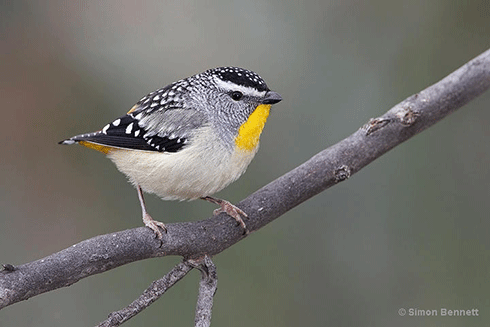
|
Published: 7 October 2013
Birds making news
To mark national Bird Week 2013 – from 19 to 25 October – BirdLife Australia is running a competition to find Australia’s favourite bird, nominating a field of 52 candidates that include some threatened species, as well as more common birds.

|
|
One of the nominated birds, the Spotted Pardalote. Credit:
S. Bennett/AustralAvianImages
|
High-profile campaigners, including Melbourne comedian Dave Hughes and Gardening Australia host Angus Stewart, will try and secure votes for their favourite bird using social media. Voting will also be promoted at walking tours, bird counts and other community events.
‘The poll for Australia’s Favourite Bird will allow all Australians to take the time to discover the phenomenal range of birds living around them,’ said Paul Sullivan, BirdLife Australia’s Chief Executive Officer.
‘Every vote counts and every one of the 52 birds has a chance to claim the title of Australia’s favourite bird.’
Voting officially opened on 1 October and closes 31 October. Mr Sullivan says the nominations include Australia’s largest owl, the Powerful Owl; the Australian Magpie; and the Laughing Kookaburra. ‘With more than 900 species of birds in Australia from which to choose, it was a tough job to narrow the list down to 52,’ he said.
In other news, Murdoch University researchers have found that Western Australia's iconic black cockatoos have been drawn to a new food source – rehabilitated mining pits.
Jessica Lee, a PhD candidate at the University, said the research team spent three years documenting the feeding habits of black cockatoos at the Newmont Boddington Gold site, 120 kilometres south east of Perth.
‘The pits we studied had been revegetated with native trees and shrubs less than 15 years ago,’ she said.
‘We were able to confirm that cockatoos were feeding at these sites after about seven years, when the plants begin producing flowers and seeds.’
The study examined the feeding habits of all three of WA’s endemic species of black cockatoo – the forest red-tailed black cockatoo, Carnaby's cockatoo and Baudin's cockatoo. All three are nationally threatened and occur only in the south-west of WA.
Dr Hugh Finn, from Murdoch University’s School of Veterinary and Life Sciences, said the findings are particularly important for industries involved in land clearing, such as mining and property development.
‘It's promising to see that these threatened cockatoos are feeding at revegetated sites after only seven years,’ he said.
‘Of course, the ideal option for native animals is to preserve the natural habitat wherever possible.’
Loss of native vegetation in the south-west is a significant threat to black cockatoos and other fauna, with land clearing for agriculture, housing and mining reducing the amount of food and shelter available for native animals.
The jarrah forest is the region's large forest area, providing food and nesting habitat for all three species of black cockatoo.
‘Food is important, but it is also critical to preserve big, old trees across the forest, particularly as hollows for cockatoos generally occur in trees that are more 200 years old,’ Dr Finn said.
Sources: BirdLife Australia/Murdoch University



